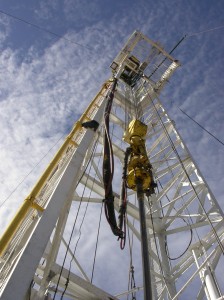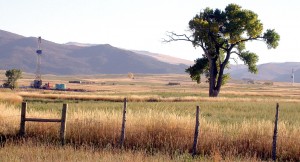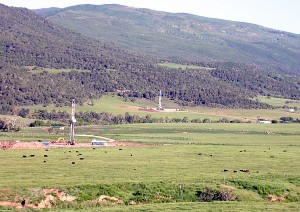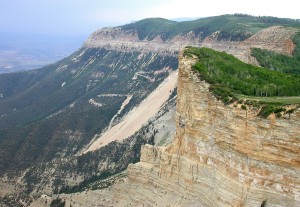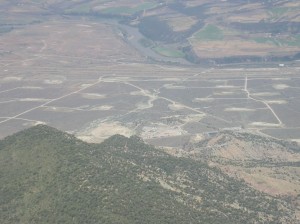Six miles down winding roads that carve through
the mesas south of Silt, the sound of gas flaring is a quiet whisper. Distant derricks jut above the ridgeline, and flames from gas flares flicker over the piñon- and juniper-spotted hills that ring an expanse of green meadows.
Three years ago, Peggy and Bob Utesch moved here from a Glenwood Springs subdivision in search of a piece of Colorado’s fast-disappearing rural heaven. As they listen to the whisper of wells flaring they’re waiting for the whisper to build to a roar, as Garfield County’s boom in natural-gas production creeps eastward, over the humpback ridges, sagebrush meadows and dry arroyos, to engulf them. A new well sits on their neighbor’s property. More are on the way.
This western Colorado big-sky country has long been ranchland. In recent years it’s become home to urban refugees and retirees. Now, it’s the target of energy companies in search of what is believed to be one of the nation’s richest reserves of natural gas as the Rockies become central to the country’s energy future.
“When we came out here three years ago, we could not see any gas wells to the west of us at all,” said Peggy Utesch, in an interview last summer. “We read about it in the paper, we knew it was an issue around Rulison and Parachute. We had no idea that it was moving this way. Right now, we can stand on our deck and count 15 wells and probably another half a dozen flares over on Mamm Creek. That is what’s moving this way and what we’re trying to keep from happening.”
This is where the nation’s energy policy – and what some fear is a looming energy crisis – literally hits the ground, on thousands of properties and public lands across central and western Garfield County.
The county has a greater density of wells than anywhere in the country, and the most active drilling rigs in Colorado. Some 300 wells have been drilled this year. Over 1,400 are already in place, producing 350 million cubic feet a day – enough to fuel three homes for a year. The county expects to see 500 drilling applications this year, and thousands more in years to come.
This may be the beginning of a century of gas extraction for Garfield County, said Rich Griebling, director of the Colorado Oil and Gas Conservation Commission. It will likely last at least several decades.
Garfield County has become the third biggest gas producer in a state likewise seeing record wells this year. Its two biggest players are Williams Production, based in Tulsa, Okla., with wells mostly around Parachute and Rulison, and the Canadian gas giant EnCana, which is spearheading a massive project in the more populated area south of Silt and Rifle.
If Garfield follows the lead of Weld, the state’s most-drilled county, that could mean 10,000 wells over the coming decades, said Ken Wonstolen, senior vice president and general counsel for the Colorado Oil & Gas Association, an industry group.
“Just to keep that in perspective,” he said, “10,000 wells in Weld County are more than exist in Saudi Arabia and Iran combined.”
Garfield County residents have found themselves caught in the midst of the West’s latest boom. It’s made unlikely allies among some environmentalists, ranchers and homeowners, pitting them against the gas industry as drilling rigs and pipelines have become common sights in back yards, pastures and federal lands.
Last spring, pirate flags that topped many EnCana rigs came down when neighbors complained their presence only added to a sense of invasion. Industry representatives say the development is needed to keep pace with unslacking energy needs.
“Even though we get a bad rap from a lot of these obstructionist groups,” said Steve Soychak, district manager at Parachute for Williams, “it seems like many of these people (working on the gas rigs) are proud to be producing a clean-burning fossil fuel and providing energy for the country.”
Industry eyes Garfield County
From the windswept mesas south of Silt to the high desert plains around Grand Junction lies Piceance (pronounced PEE-awnce) Basin, 6,000 square miles bordered by the jagged Grand Hogback, near New Castle, and the Douglas Creek Arch, on the county’s western edge. Some 6,000 to 10,000 feet below runs the Williams Fork formation, a strip of tightly packed sandstone laden with pockets of natural gas, long considered rich but unreachable. Four big hot spots lie near Parachute and Rulison, and in the Mamm Creek field south of Silt and Rifle.
One hundred million years ago, this arid landscape was the shore of a swampy inland sea that stretched to the middle of the continent. The dead organic material that washed up here, under pressure for millions of years, became coal. Heated under pressure, it gave off gases, like methane. Gases that remained in the coal kill canaries and coal miners, ignite underground fires and are gathered as coalbed methane. Other gases percolated into underground pockets. That’s the natural gas most energy companies collect in the Piceance Basin today.
“It’s one of the more significant plays in the country,” said COGA’s Wonstolen. “I think the national leadership is looking at the Piceance and other basins like it in the country to be increasingly sources of supply in the U.S.”
The Colorado Geological Survey estimates the field may hold 311 trillion cubic feet of natural gas. That would be enough to fuel the United States’ natural gas needs for the next decade. The area between Silt and Parachute could hold a third of that.
But only a fraction may ever be economical to pull out. Ron Johnson, a geologist with the U.S. Geological Survey, said the actual yield may be only 5 or 10 trillion cubic feet.
“That’s a six-month supply,” he said. “That’s not an enormous amount in the grand scheme of things, but when you look at each basin and kind of add them together, it adds up to quite a bit.”
Industry groups say it could yield more than that.
“It’s always been known that there’s a lot of natural gas in place,” Griebling said. “About a hundred (billion cubic feet) per square mile. The challenge has always been, how do you get that gas out?”
The first well dates back to 1955. Since then, technological advances have made natural gas easier to extract, including improvements in fracturing the rock by forcing in water or chemicals. Rising gas prices have made extraction more cost-effective. And dwindling reserves in standbys like Texas and Oklahoma are drying up, making the West’s long-overlooked supplies critical.
Each well can cost energy companies more than $1 million, but they can yield five times that in gas revenues.
“You combine … increasing demand leading to higher prices, better technology and a gas-rich area,” Wonstolen said, “and it all comes together to make this one of the big plays going on in the West.”
Randy Udall, director of the nonprofit Center on Resource Efficiency, based in Aspen and Carbondale, says the pressure is high on up-and-coming producers like Colorado. In the next three years, he said, more than half the gas we use will have to come from new wells as old wells run dry.
“This is the nation’s gas appetite that’s landed in Garfield County,” he said.
That’s put landowners on a collision course with energy interests, as ranchers find rigs and pipelines disturbing pastures and fence lines, and homeowners find drilling rigs the very opposite of the quiet, pastoral beauty they moved to the country to find.
“There are a lot of dream homes that are no longer dream homes for people because they’re dealing with drilling right now,” said Garfield County Commissioner Trési Houpt. “That’s the reality of that area.”
‘A subdivision from hell’
Opponents complain about the scarring of the landscape to make room for well pads, and the network of roads cut to access them. Once-quiet lanes fill with workers and trucks. Pipelines cut across pastures. Nonstop drill rigs make noise while they dig, and compressor stations that keep wells pumping never go away.
“When you look down on these gas fields from the air, they sort of look like a subdivision from hell,” Udall said.
Residents worry about chemicals, odors and the danger of leaks. They worry their water supplies could become polluted or run dry. And they say wildlife is chased away. For ranchers, a poorly placed well can harm their operations and a broken fence can be a nightmare.
The drilling is over in about five months. The wells, much less conspicuous than big drill rigs, will produce gas for 30 or 40 years.
“There are a lot of impacts that I think are going to fundamentally change the nature of that landscape,” Udall said.
Industry representatives say those fears are overblown. Once revegetated, they say, well pads are hard to find. Water is protected by well linings and tight rock layers that don’t let the gas filter into water supplies. EnCana recently completed air-quality tests that found evidence of seven of 61 chemicals tested for, and no health risks.
Environmentalists also worry about federal lands they say are endangered by many of the same impacts. Most attention has been paid to the Roan Plateau, a vast mesa northwest of Rifle. But it’s just one of many areas in Garfield County and across the West where public lands – mostly Bureau of Land Management lands – are being targeted by energy interests.
‘Windfall’
In the midst of the development, Garfield County has seen a financial windfall. The gas industry accounts for about a quarter of the county’s revenues. In 2002, it gave the county $12.8 million. Add to that another $364,000 in money turned over from the state in severance taxes and from the federal government in federal mineral leases, plus royalties collected from gas pumped from county-owned land. Last year, Williams was the county’s largest single taxpayer.
The industry also provides jobs, far better paying than the service industry. The average salary runs between $45,000 and $50,000, nearly twice Garfield County’s average wage.
“A lot of these kids were going to Aspen and commuting that far in the construction boom,” said Williams’ Soychak. “Now they can work for as much money or more in the local area and not have to drive as far.”
Most, though, come from places like Wyoming and Utah, contractors who follow the rigs across the West. They work a week, then go home for a week.
Boosters say the benefits cross over to area businesses.
“I defy you to go into a restaurant in Rifle or Silt and not find someone in there working for EnCana,” said Richard Eberspecher, that company’s drilling superintendent in Rifle. “You try getting a motel room.”
Last year, Garfield County received severance taxes from the state based on nearly 500 people working in the county in the gas industry. Those numbers are likely to grow.
“Natural gas is going to be the leading economic driver in Garfield County over the next 30 or 40 years,” Udall said. “It’s gonna be an enormous industry that has huge economic impacts, huge social impacts and huge environmental impacts. The nation’s gas appetite is growing rapidly. … The pressure to get gas out of the Rockies is only going to grow over the next decades.”
That means a mixed bag of benefits and conflicts as the Piceance Basin increasingly becomes a target for energy interests.
“As a country we take energy for granted,” Soychak said. “We think natural gas comes from a stove. We don’t realize it takes some effort to extract it from the ground.”

